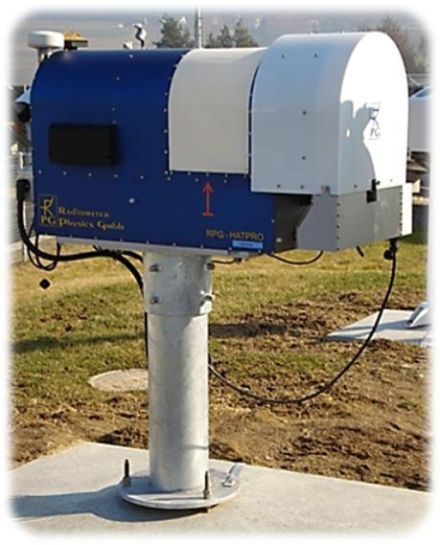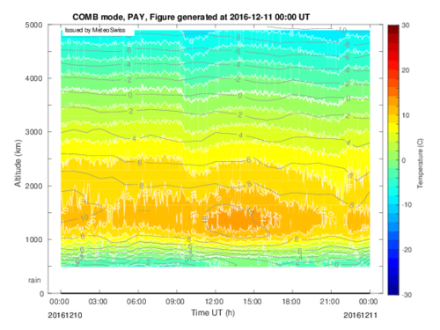Service Navigation
Search
The molecules in the atmosphere emit electromagnetic radiation in the microwave region which can be measured by microwave radiometers. The profile of temperature, humidity and ozone can then be derived from the frequency dependence of the measured radiation. Radiometers are automatic instruments and acquire data at a high temporal resolution. MeteoSwiss provides tropospheric temperature and humidity profiles every 10 minutes and stratospheric ozone profiles every 30 minutes.
Measurement of Temperature and Humidity
MeteoSwiss uses two radiometer types to measure temperature and humidity profiles. The temperature profiler TEMPRO and the combined temperature and humidity profiler HATPRO. Both instruments provide every 10 minutes vertical profiles from ground up to approximately 6 km. The average vertical resolution is around 500 m. Temperature and Water vapor profiles are retrieved from radiation measurements in 2 bands (7 channels between 22 and 31 GHz for water vapor profiling and 7 channels between 51 and 58 GHz for Temperature profiling) with a built-in quadratic regression algorithm based on a climatology of Payerne radiosondes.

Application of Temperature Measurements
The temperature profiles allow to detect certain patterns in the atmosphere like temperature inversions in the troposphere. The temperature and humidity radiometers are also used in the meteorological surveillance tool of nuclear power plants (EMER-Met).

HATPRO and TEMPRO
- Löhnert, U. and Maier, O.: Operational profiling of temperature using ground-based microwave radiometry at Payerne: prospects and challenges, Atmos. Meas. Tech., 5, 1121-1134, doi:10.5194/amt-5-1121-2012, 2012.
- Calpini, B., Ruffieux, D., Bettems, J.-M., Hug, C., Huguenin, P., Isaak, H.-P., Kaufmann, P., Maier, O., and Steiner, P.: Ground-based remote sensing profiling and numerical weather prediction model to manage nuclear power plants meteorological surveillance in Switzerland, Atmos. Meas. Tech. Discuss., 4, 789-813, doi:10.5194/amtd-4-789-2011, 2011.